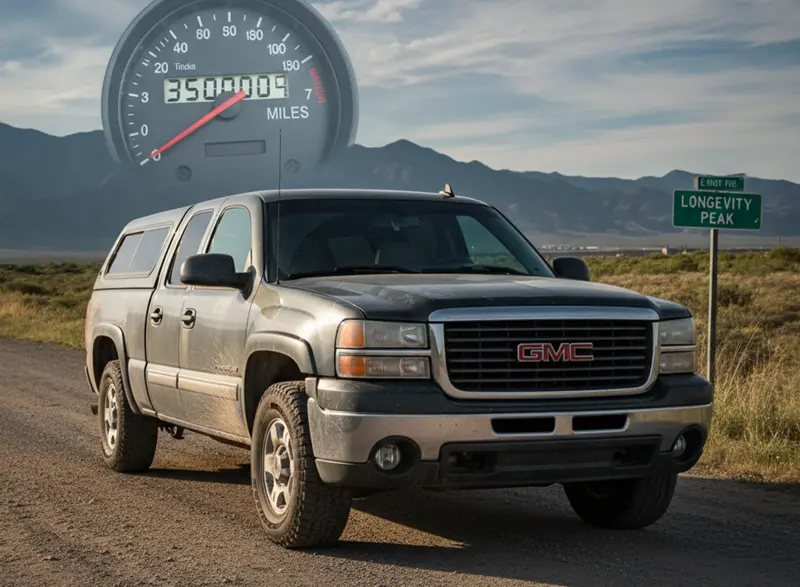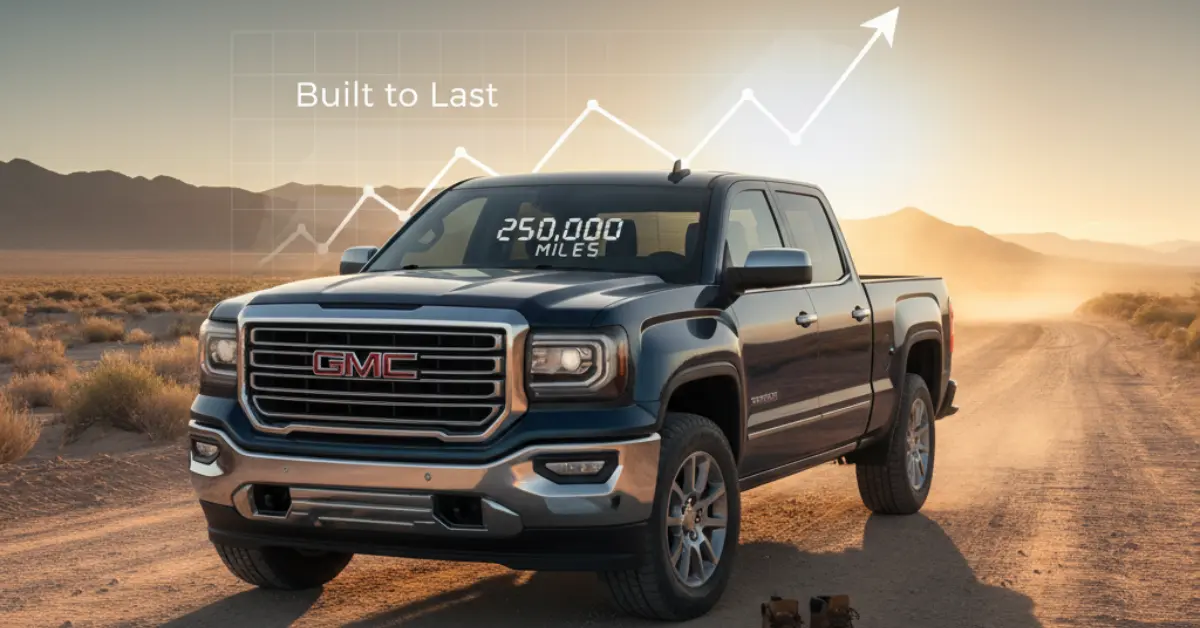The GMC Sierra isn’t just a truck. For many, it’s a legacy and a staple from General Motors. Whether it’s a tough work truck hauling materials or a luxury Denali towing the family boat, the Sierra has built a reputation on a foundation of durability and longevity. But when you’re buying a vehicle, you need to know it’s built to last. You’re not just buying transportation; you’re buying a partner.
This guide explores the lifespan of a GMC Sierra, a topic of great interest among truck enthusiasts. We’ll get straight to the point and show you how long GMC trucks last, from the older Vortec engines to the modern Duramax diesels, helping you make a smarter choice.
What is the Lifespan of a GMC Sierra?
Let’s get right to the point: What is the average lifespan of a GMC? A well-maintained GMC Sierra can last for 200,000 to 300,000 miles.
In fact, many of these trucks are known to go well beyond that milestone. Many owners proudly share photos of their high-mileage odometers. With proper care, legendary engines like the iron-block Vortec V8s or modern Duramax diesels can often surpass 300,000 miles.
However, reaching that high-mileage club isn’t a guarantee. A Sierra’s actual service life depends heavily on a few key factors that influence the lifespan of the vehicle.
Key Factors That Determine a Sierra’s Lifespan
Not all GMC models are created equal, and how they’re treated matters most. Here’s what separates a 150,000-mile pickup truck from a 350,000-mile legend.
Engine & Drivetrain Configuration
The heart of the truck, its engine and drivetrain, is the most important factor.
A simple, standard iron-block Vortec V8 has fewer complex parts than a modern EcoTec3 or TurboMax engine with its modern fuel-saving technology. Similarly, a tough Duramax diesel is built differently; it was made to last.
Maintenance History & Quality
This is the single most important thing. A used GMC Sierra with records showing regular oil changes, fluid flushes, and new filters has a much better chance of lasting a long time.
Using quality oil and fluids isn’t just a suggestion; it’s the key to making your truck last longer. Simply put, proper maintenance isn’t optional.
Model Year & Generation
Technology and manufacturing processes change over time. That means specific generations of the GMC Sierra have unique strengths and weaknesses that directly affect their long-term durability. An issue you see in one model year might be completely fixed in the next.
Driving Habits & Environment
How and where you drive your Sierra plays a huge role in wear and tear.
A truck that spends its life on the highway will hold up better than one used for towing heavy loads or that’s been driven aggressively.
Similarly, a 4×4 truck from the ‘rust belt’ is much more likely to have rust issues than one from a dry climate.
What Is Considered High Mileage for a GMC Sierra?

In the truck world, the numbers tell a different story. For many cars, 150,000 miles means it’s almost done. For a GMC Sierra, 150,000 miles can be just the start of its second life.
A Sierra with this high mileage, provided there’s solid proof of regular maintenance, still has a lot of life left. If you’re looking at a used GMC Sierra with high miles, don’t write it off. Instead, ask: “How well was this truck cared for?” That answer is far more important than the number on the odometer.”
GMC Sierra Longevity by Generation
Each generation brought new technology. Here’s a breakdown of what to expect.
5th Generation (2019-Present) [T1 Platform]
The latest Sierras, including the rugged AT4 trim, are packed with tech like the 10-speed automatic transmission and Dynamic Fuel Management (DFM). The long-term outlook is promising, especially for the 3.0L Duramax diesel, known for great fuel economy for a truck this big.
4th Generation (2014-2018) [K2XX Platform]
This generation is defined by well-documented issues that impact its longevity reputation. The Active Fuel Management (AFM) system on V8s is known for lifter failure, and the early 8-speed automatic transmissions (the 8L90 and 8L45) could suffer from torque converter shudder.
3rd Generation (2007-2013) [GMT900 Platform]
For many, this generation is a ‘sweet spot,’ but it’s important to know the difference between the early and late models. The later years, 2011-2013, are highly sought after. They feature the durable 6-speed automatic and refined Vortec engines. Earlier years (2007-2010) had more serious issues with the first-gen AFM and, in some cases, excessive oil consumption.
2nd Generation (1999-2006) [GMT800 Platform]
These trucks are built for simplicity and durability. The 2003-2006 ‘Cateye Sierra’ models are high-mileage heroes. They came with the very popular, non-AFM Vortec V8s (5.3L Vortec, 6.0L Vortec) that are famous for their reliability.
Which Sierra Engine Lasts the Longest?
The engine you choose is the biggest decision you’ll make.
The Legendary Vortec V8s (4.8L, 5.3L, 6.0L)
These iron-block V8s are the benchmark for reliability. With basic care, it’s common to see these engines surpass 300,000 miles.
3.0L Duramax I-6 Turbodiesel: The Modern Longevity King
The ‘baby Duramax’ has quickly earned a reputation for being a smooth and durable diesel, and it’s expected to last 300,000-400,000+ miles.”
6.2L EcoTec3 V8: The Robust, High-Power V8
The 6.2L is a beast. If you take great care of it, these powerful engines can reliably last 250,000-300,000 miles.
5.3L EcoTec3 V8: The Common Workhorse
This is the most common engine you’ll find. It’s the one most associated with AFM/DFM lifter issues. It typically lasts around 200,000-250,000 miles.
2.7L TurboMax I-4: The Modern Powerhouse
This newer engine is expected to last a solid 200,000 miles, but we’re still waiting on long-term data.
Common Problems on High-Mileage GMC Sierras
Even the toughest trucks used for work have weak points. Here are symptoms to watch for and how to diagnose them.
Engine Issue: AFM/DFM Lifter Failure
- What it is: The lifters in the cylinder deactivation system can fail, leading to misfires and potential engine damage.
- Symptoms: A distinct ticking noise, check engine light, and rough running.
- Prevention: Frequent, high-quality oil changes are key. An out-of-warranty AFM/DFM lifter repair is one of the more costly common repairs, with repair costs ranging from $2,500 to over $4,000, so installing an AFM delete kit is a smart preventative measure.
Transmission Issue: Torque Converter Shudder & Hard Shifting
- What it is: Primarily affecting the 8-speed automatic, this feels like driving over a rumble strip. GM issued multiple Technical Service Bulletins (TSBs) for this.
- Symptoms: A noticeable torque converter shudder, vibration, hard shifting, jerking, or what feels like a slipping transmission.
- Prevention: The recommended fix is a complete transmission flush and replacement with an updated transmission fluid. This service costs a few hundred dollars, but if the torque converter needs replacement, the repair can exceed $2,000.
Frame & Body Issue: Rust and Corrosion
- What it is: Rust is a major enemy, especially for work trucks in snowy climates.
- Common spots to check: Frame rust is a major concern. Also inspect the cab corners, rocker panels, and rear wheel arches.
- Prevention: Regular washes and rust-proofing can add years to the body and frame.
Electrical & Infotainment Gremlins
- What it is: Issues can range from radio problems to a complete infotainment screen blackout.
- Common symptoms: Unresponsive screens, faulty sensors, or intermittent features.
- Solutions: Often, a software update from a dealership can fix screen issues, while others require a technician to trace faulty wiring.
The Most Reliable GMC Sierra Years (And Which to Approach with Caution)
Best Bet for Reliability: 2011-2013 (with the 6-speed transmission)
Trucks from these years offer a fantastic balance of modern capability and old-school durability.
A Modern & Reliable Choice: 2022-Present (with 3.0L Duramax or 6.2L V8)
These recent GMC models are a solid choice for long-term ownership, with many earlier issues resolved.
Years to Scrutinize: 2014-2018 (V8 models with 8-speed transmission)
If you’re considering a GMC Sierra from this era, a thorough inspection and detailed service history are a must.
GMC Sierra Longevity vs. Competitors
GMC Sierra vs. Toyota Tundra
The Toyota Tundra has a leading reputation for reliability. However, the Sierra often offers better towing tech and more engine options.
GMC Sierra vs. Ford F-150
The Ford F-150 and Sierra are highly competitive. For both trucks, how long they last really depends on the specific engine you choose.
GMC Sierra vs. Ram 1500
The Ram 1500 is praised for its ride but can be more prone to rust and Hemi lifter issues. The Sierra often has a slight edge in powertrain durability.
GMC Sierra vs. Chevy Silverado
The GMC Sierra and Chevrolet Silverado are mechanical twins from General Motors. Any discussion of reliability, longevity, or common problems applies equally to both.
How to Make Your GMC Sierra Last 300,000+ Miles: A Maintenance Checklist
Fluid & Filter Intervals (The #1 Priority)
This is how you ensure a long service life.
- Engine Oil & Filter: Every 5,000-7,500 miles with quality full synthetic Motor oil.
- Transmission Fluid & Filter: Every 50,000-60,000 miles.
- Front/Rear Differential Fluid: Every 50,000 miles, especially if you tow.
- Coolant (Antifreeze): Flush and replace every 100,000-150,000 miles.
Address Common Failure Points Proactively
Address issues before they become major problems. For an out-of-warranty V8, consider an AFM/DFM disabler to prevent catastrophic lifter failure.
Preventative Body and Chassis Care
Regularly wash the undercarriage and consider rust-proofing to prevent corrosion.
Buying a Used High-Mileage GMC Sierra: A 10-Point Checklist
If you’re looking at a used gmc truck, follow this list.
- Listen for Engine Ticking: The tell-tale sign of AFM/DFM lifter wear.
- Test Drive for Shifting Quality: Feel for any shuddering or hard shifting.
- Inspect for rust: Thoroughly check frame rust, cab corners, and rocker panels.
- Demand Maintenance Records: The single most important indicator of a truck’s past life.
- Check for Oil Leaks: Look around the oil pan and rear main seal.
- Test the 4WD System: Engage both 4-Hi and 4-Lo, a must for any Four-wheel drive vehicle.
- Check for Suspension Wear: Look for leaking shocks and check tire wear patterns.
- Inspect Tire Wear Patterns: Uneven wear can signal underlying alignment or suspension issues.
- Verify All Electronics Work: Test the infotainment screen, power windows, seats, etc.
- Get a Professional Pre-Purchase Inspection (PPI): This is a non-negotiable step before buying any used truck.
The Payoff: How Longevity Impacts the GMC Sierra’s Resale Value
The GMC Sierra is a powerful and capable pickup truck that holds its value well. Its reputation means that even a used GMC with over 100,000 miles commands a strong price, making a well-maintained example a solid investment.
Annual Maintenance Costs for a GMC Sierra
The annual maintenance cost or overall cost of ownership is reasonable. Expect to spend $500 to $700 per year on routine maintenance like oil changes and filters.
Conclusion: Is the GMC Sierra a Truck You Can Count On?
Absolutely. The GMC Sierra has earned its place as a dependable truck you can count on. By choosing a reliable GMC from a good generation and keeping up with proper maintenance, your Sierra could last well over 200,000 miles. If you’re looking for a truck that fits your needs, it’s a great option. Visit your local City GMC or Buick GMC dealership to check out their selection and find the perfect one for you. We recommend scheduling a test drive to experience it firsthand.
Frequently Asked Questions (FAQ)
1. What is considered high mileage for a GMC Sierra?
Over 150,000 miles is high mileage, but for a well-maintained Sierra, this is often just the halfway point of its life.
2. At what mileage do GMC Sierras typically start having problems?
Around 100,000-120,000 miles is when wear-and-tear items need attention. This is also when AFM lifter failure can appear if maintenance has been neglected.
3. Is a GMC Sierra with 200,000 miles worth buying?
It can be an excellent investment if it has complete service records, passes a pre-purchase inspection (PPI), and is priced right.
4. Can a GMC Sierra reach 500,000 miles?
Yes, it is possible for the GMC Sierra to reach high numbers, though it’s rare for any truck to last that long. It typically requires a Duramax or non-AFM Vortec engine and excellent care.
5. How long does a GMC Sierra transmission typically last?
A GMC Sierra transmission can last as long as 200,000-300,000 miles with regular transmission fluid changes.
6. Which GMC Sierra years are the most reliable and which should I avoid?
– Most Reliable: 2011-2013 and 2022-Present.
– Years to Scrutinize: 2014-2018 models and early 3rd gen models (2007-2010).
7. Which is more reliable, a Sierra or a Silverado?
They are equally reliable. As products of General Motors, the GMC Sierra and Chevrolet Silverado are mechanically identical. Reliability ratings from sources like J.D. Power or Consumer Reports often group them together.
8. Does towing reduce the lifespan of a GMC Sierra?
Yes, frequent towing of heavy loads puts additional stress on the engine, transmission, and brakes, which can accelerate wear and tear and reduce the overall lifespan of your GMC Sierra.

Eric L. Friedman is a car expert who has worked on Chevy and GMC trucks for over 10 years. He started AutoYolo to help people fix their own cars. On the blog, he shares easy tips, step-by-step guides, and repair advice to make car problems less stressful and more affordable.

